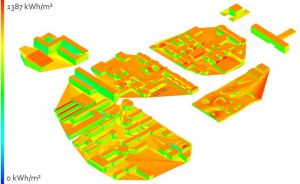Urban forms, surface materials, the presence of vegetation and water bodies, and the concentration of human activity have a real influence on the urban microclimate. In particular, the dense urban morphologies are "traps for solar and thermal radiation" while the surfaces of the frames absorb and store some of this energy.
Screenshot software CitySim – source: Kaemco
This microclimate is more often characterized by higher temperatures in the Center cities than on their outskirts, called urban heat island phenomenon. In the winter, so these are milder temperatures and thus consumption of heating lower than in rural areas, but also of the peaks of heat stressed in the summer, sometimes suffocating. More than just a source of thermal discomfort for city dwellers, urban heat island is moving to the center of political and social concerns, in order to limit the health impacts of heat waves that should multiply in temperate zones in the coming years according to the IPCC.
Accurately predict the micro-climates linked to new urban developments is therefore crucial. Take into account all aspects and their interactions requires a combination of quite comprehensive and complex physical models (models thermo-radiatifs, air, évapo-transpiratifs and anthropogenic effects). These are based on the 3D geometry of the buildings, their construction materials and its mode of occupation, but also data on their environment, vegetation, soil, human activity (especially transport) etc… all data that can deliver city CityGML models.
Schematic Cup of visualization of temperatures in 2008 for a night of heat – source: Group DESCARTES
Initiatives & contacts
SOLENE, development of a tool for simulations of the urban microclimate platform.
- Author: School of architecture of Nantes (NICHE)
- Contacts: Thomas Leduc, Marjorie Musy.
CITYSIM, urban energy simulation software
- Author: School Polytechnique Federal de Lausanne, now managed by Kaemco
- Contact: Silvia Coccolo, Jérôme Kaempf.


